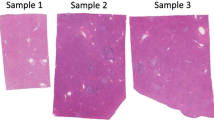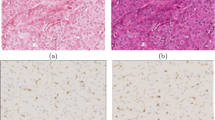Abstract
The stained colors of the tissue components are popularly used as features for image analysis. However, variations in the staining condition of the histology slides prompt variations to the color distribution of the stained tissue samples which could impact the accuracy of the analysis. In this paper, we present a method to correct the staining condition of a histology image. In the method, a look-up table (LUT) based on the dye amounts absorbed by the sample is built. The LUT can be built when either (i) the source and reference staining conditions are specified or (ii) when the user simply wants to recreate his/her preferred staining condition without specifying any reference slide. The effectiveness of the present method was evaluated in two aspects: (i) CIELAB color difference of nuclei, cytoplasm, and red blood cells, between the ten different slides of liver tissue, and (ii) classification of the different tissue components. Application of the present staining correction method reduced the color difference between the slides by an average factor of 9.8 and the classification performance of a linear discriminant classifier improved by 16.5 % on the average. Results of the paired t test statistical analysis further showed that the reduction in the CIELAB color difference between the slides and the improvement in the classifier’s performance when staining correction was implemented is significant at p < 0.001.








Similar content being viewed by others
References
Yeh FC, Parwani AV, Pantanowitz L, Ho C: Automated grading of renal cell carcinoma using whole slide imaging. J Pathol Inform 4(5):23, 2014
Rizzardi AE, Johnson AT, Vogel RI, et al: Quantitative comparison of immunohistochemical staining measured by digital image analysis versus pathologist visual scoring. Diagn Pathol 7:42, 2012
Ghaznavi F, Evans A, Madabhushi A, Feldman M: Digital imaging in pathology: whole-slide imaging and beyond. Annu Rev Pathol 8:331–359, 2013
Walkowski S, Szymas J: Histopathologic patterns of nervous system tumors based on computer vision methods and whole slide imaging (WSI). Anal Cell Pathol 35(2):117–122, 2012
Abe T, Hashiguchi A, Yamazaki K, Ebinuma H, Saito H, Kumada H, et al: Quantification of collagen and elastic fibers using whole slide images of liver biopsy specimens”. Pathol Int 63:305–310, 2013
Ficsor L, Varga VS, Tagscherer A, Tulassay Z, Molnar B: Automated classification of inflammation in colon histological sections based on digital microscopy and advanced image analysis. Cytom A 73(3):230–237, 2008
Karaçali B, Tözeren A: Automated detection of regions of interest for tissue microarray experiments: an image texture analysis. BMC Med Imaging 7:2, 2007
Tuominen VJ, Tolonen TT, Isola J: ImmunoMembrane: a publicly available web application for digital image analysis of HER2 immunohistochemistry. Histopathology 60(5):758–767, 2012
He L, Long LR, Antani S, Thoma GR: Histology image analysis for carcinoma detection and grading. Comput Methods Prog Biomed 107(3):538–556, 2012
Basavanhally AN, Ganesan S, Agner S, et al: Computerized image-based detection and grading of lymphocytic infiltration in HER2+ breast cancerhistopathology. IEEE Trans Biomed Eng 57(3):642–653, 2010
Bahlmann C, Patel A, Johnson J, Ni J, et al: Automated Detection of Diagnostically Relevant Regions in H&E Stained Digital Pathology Slides, Proc. SPIE 8315, Medical Imaging: Computer-Aided Diagnosis, February 23, 2012. doi:10.1117/12.912484
Pham N-A, Morrison A, Schwock J, Aviel-Ronen S, et al: Quantitative image analysis of immunohistochemical stains using a CMYK color model. Diagn Pathol 2:8, 2007
McCann MT, Bhagavatula R, Fickus MC, et al: Automated colitis detection from endoscopic biopsies as a tissue screening tool in diagnostic pathology Image Processing (ICIP), 2012 19th IEEE International Conference on September 30, 2012–October 3, 2012. doi:10.1109/ICIP.2012.6467483
Bautista PA, Abe T, Yamaguchi M, et al: Digital staining of pathological images: dye amount correction for improved classification performance. Proc. SPIE Medical Imaging: Computer-Aided Diagnosis, March 30, 2007. doi:10.1117/12.710446
Abe T, Murakami Y, Yamaguchi M, et al: Color correction of pathological images based on dye amount quantification. Opt Rev 12:293–300, 2005
Kuru K:“ Optimization and enhancement of H&E stained microscopical images by applying bilinear interpolation method on lab color mode”, Theor Biol Med Model, Feb 6, 2014. doi:10.1186/1742-4682-11-9
Murakami Y, Abe T, Hashiguchi A, Yamaguchi M, Saito A, Sakamoto M: Color correction for automatic fibrosis quantification in liver biopsy specimen. J Pathol Inform 4:36, 2013
Kothari S, Phan JH, Moffitt RA, Stokes TH, et al: Automatic Batch- Invariant Color Segmentation of Histological Cancer Images. Biomedical Imaging: From Nano to Macro, 2011 IEEE International Symposium on March 30, 2011–April 2, 2011. doi:\10.1109/ISBI.2011.5872492
Basavanhally A, Madabhushi A: EM-Based Segmentation-Driven Color Standardization of Digitized Histopathology. Proc. SPIE 8676, Medical Imaging 2013: Digital Pathology, 86760G, March 29, 2013. doi:10.1117/12.2007173
Niethammer M, Borland D, Marron JS, et al: Appearance normalization of histology slides. Mach Learn Med Imaging Lect Notes Comput Sci Vol 6357:58–66, 2010
Khan AM, Rajpoot N, Treanor D, Magee D: Nonlinear mapping approach to stain normalization in digital histopathology images using image-specificcolor deconvolution. IEEE Trans Biomed Eng 61(6):1729–1738, 2014
Magee D, Treanor D, Crellin D, et al: Colour Normalization in Digital Histopathology Images. Proc. Opt. Tissue Image Anal. Microsc., Histopathol. Endosc.,100–111, 2009
Ruifok AC, Johnston DA: Quantification of histochemical staining by color deconvolution. Anal Quant Cytol Histol 23(4):291–299, 2001
Srivastava S, Ha TH, Delp EJ, Allebach JP: Generating Optimal Look-up Tables to achieve complex color space transformations ,Image Processing (ICIP), 2009 16th IEEE International Conference on 1641–1644, 2009
Bautista PA, Yagi Y: Multispectral enhancement method to increase the visual differences of tissue structures in stained histopathology image. Anal Cell Pathol 35((5-6)):407–420, 2012
Matlab Technical Computing Version R2008a
Wyszecki G, Stiles WS: Color science concepts and methods quantitative data and formulae, 2nd edition. Wiley, New York, 1982
Zhang H, Liu H, Quan S: Hue constrained matrix optimization for preferred color reproduction. J Electron Imaging 21(3):033021, 2012
Bautista PA, Hashimoto N, Yagi Y: Color standardization in whole slide imaging using a color calibration slide. J Pathol Inf 5:4, 2014
Bautista PA, Yagi Y: Improving the visualization of tissue folds in whole slide images through color enhancement, J Pathol Inform, November 29, 2010. doi:10.4103/2153-3539.73320
Badano A, Revie C, Casertano A, ChengWC, et al: Consistency and standardization in medical imaging: a consensus report. J Digit Imaging, 2014. doi:10.1007/s10278-014-9721-0
Yagi Y: Color standardization and optimization in whole slide imaging. Diagn Pathol 6(Suppl 1):S15, 2011
Shrestha P, Hulsken B: Color accuracy and reproducibility in whole slide imaging scanners. Proc. SPIE Medical Imaging: Digital Pathology, March 20, 2014. doi:10.1117/12.2048769
Hashimoto N, Bautista PA, Yamaguchi M, Ohyama N, Yagi Y: Referenceless image quality evaluation for whole slide imaging. J Pathol Inform 3:9, 2012
Johnson JP, Krupinski EA, Yan M, et al: Using a visual discrimination model for the detection of compression artifacts in virtual pathology images. IEEE Trans Med Imaging 30(2):306–314, 2011
Author information
Authors and Affiliations
Corresponding author
Rights and permissions
About this article
Cite this article
Bautista, P.A., Yagi, Y. Staining Correction in Digital Pathology by Utilizing a Dye Amount Table. J Digit Imaging 28, 283–294 (2015). https://doi.org/10.1007/s10278-014-9766-0
Published:
Issue Date:
DOI: https://doi.org/10.1007/s10278-014-9766-0




